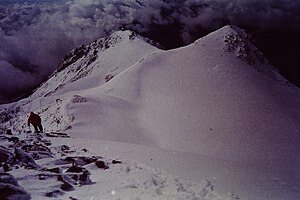Iztaccíhuatl
| Iztaccíhuatl | ||
|---|---|---|
|
Iztaccíhuatl from the northwest on the Puebla-DF road near Chalco |
||
| height | 5230 m | |
| location | Puebla - México border , Mexico | |
| Coordinates | 19 ° 10 ′ 39 ″ N , 98 ° 37 ′ 58 ″ W | |
|
|
||
| Type | Stratovolcano | |
| First ascent | 1889 by James de Salis | |
| Normal way | Alpine tour | |
|
South ridge to the refuge |
||
The Iztaccihuatl [ istaksiwatɬ ] (also Ixtaccihuatl [ iʃtaksiwatɬ ] in new Nahuatl notation Istaksiwatl even Iztactépetl or Istaktepetl or Mujer dormida , sleeping woman ') is with 5230 m the third highest mountain in Mexico after the Pico de Orizaba and Popocatépetl .
Surname
The volcano has three peaks, which are associated with the head, chest and feet of a sleeping woman. His name comes from Nahuatl and means "white woman" in German. The short form Ixta is also occasionally used for the mountain .
location
It is located approx. 70 km southeast of the capital Mexico City and can be seen from the city in good visibility. The Iztaccíhuatl is located 18 km north of the Popocatépetl and is separated from it by the approximately 3700 m high Paso de Cortés .
Ascent
The official first ascent took place in 1889 by James de Salis, but archaeological research has shown that the mountain must have been climbed by the Aztecs and even earlier cultures. The easiest ascent begins in the south of the mountain and takes place over the Portillo de los Pies gap . In the further course the pre-summit Torre de San Agustín , 5020 m , is exceeded. Another minor summit follows, the Rodillas , 5100 m . You have to expect ice here. Then we continue over the south ridge to the main summit of the Pecho , 5286 m . The time required for ascent and descent is about two days.
The legend of Popocatépetl and Iztaccíhuatl
In Aztec mythology , Iztaccíhuatl was a princess who fell in love with one of her father's warriors. Her father sent the warrior on a campaign in Oaxaca . The father promised the warrior his daughter if he would return (which the father did not believe). The daughter was told that her lover was dead, after which she died of grief. When the warrior returned, however, he died again from grief at having lost her. The gods covered the two of them with snow and turned them into mountains. The snow-covered mountain Iztaccíhuatl is therefore also called the "white woman" because it resembles a woman lying on her back. The warrior became the Popocatépetl volcano, which breathes fire out of anger at the loss of loved ones.
Web links
- Iztaccíhuatl in the Global Volcanism Program of the Smithsonian Institution (English)
Individual evidence
- ^ Peter Rotter: Mexico. Trekking travel guide for mountaineers and individualists , self-published by Rotter, 1992, p. 35 ff.
- ^ Peter Rotter: Mexico. Trekking travel guide for mountaineers and individualists , self-published by Rotter, 1992, map insert 1: 50,000
- ^ Peter Rotter: Mexico. Trekking travel guide for mountaineers and individualists , self-published by Rotter, 1992, p. 37 ff.


